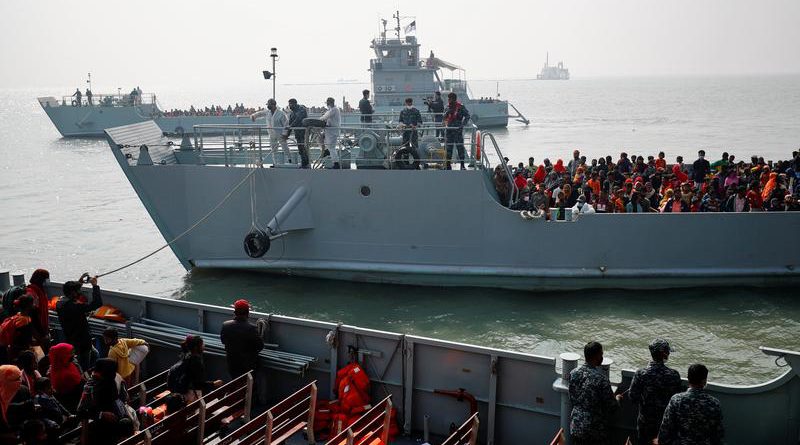‘Pray floods don’t kill us’: A day on Rohingya’s remote Bangladesh island
Reuters
“Welcome to Bhasan Char,” read a banner as the refugees walked off the jetty on the island…
As a Bangladeshi naval ship anchored off a remote Bay of Bengal island, some of the Rohingya Muslim refugees aboard clapped in anticipation of starting a new life on a piece of land that did not even exist two decades ago.
Carrying poultry and sacks of belongings, they are part of a second group of about 1,800 Rohingya that Bangladesh moved on Tuesday from cramped refugee camps on the mainland to the low-lying island despite opposition from rights groups.
“Welcome to Bhasan Char,” read a banner as the refugees walked off the jetty on the island, nearly as big as Manhattan. Navy trucks and tractor trailers took them to multiple rows of concrete houses with their pinkish-red painted tin roofs.
A Reuters photographer was among a team of journalists given rare access to the island that is about three hours from the nearest port in Chittagong, and is fully exposed to nature’s vagaries in a country with a tragic history of deadly storms.
Bangladesh says it has spent more than $350 million of its own money to ready housing and other infrastructure to voluntarily move some 100,000 Rohingya to the island in an effort to ease overcrowding in camps near the Myanmar border, even though rights groups said many were being coerced or paid to move. The government denies the charges.
“Mashallah! Wonderful place,” one man, a father of six, exclaimed using an Arabic expression for appreciation at the arrangements at Bhasan Char.
“We are so happy with the accommodation. The children are so excited to see the playground,” he said, but added: “We just pray floods don’t kill us.”
Cheek by Jowl
The government said earlier this month that the housing was built on concrete foundation which could withstand natural disasters, noting it withstood cyclone Amphan in May which killed more than 100 people in Bangladesh and eastern India.
A middle-aged man who reached Bhasan Char with his wife and three children on Tuesday said his camp leader had convinced him that they were better off relocating than staying back in the dilapidated shelters on the mainland where one million of them live cheek by jowl.
Reuters is withholding the names of the Rohingya to protect their identity as some in the community are against the move to the isolated island from where they won’t be allowed to leave without government permission.
The government has built a 2-metre (6.5 feet) high embankment for 12 kms (7.5 miles) to protect the island, where sheep grazed on its greenish-grey grass as the new arrivals were screened for coronavirus by health workers in white overalls.
Reuters was not allowed to meet with a previous group of some 1,600 Rohingya that was relocated early this month, but a Navy SUV drove journalists through the cemented lanes separating neat rows of grey-walled housing blocks with wide porches.
Journalists were also shown around an empty room with two steel-and-plastic bunk beds for four people, a community kitchen with multiple stoves separated by small concrete partitions and a fresh-water pond. A big white bungalow enclosed with a fence is reserved for VVIPs in case anyone fancies a visit.
“The Rohingya people who have shifted there are very happy with the arrangement,” Foreign Minister Abdul Momen told Reuters.



